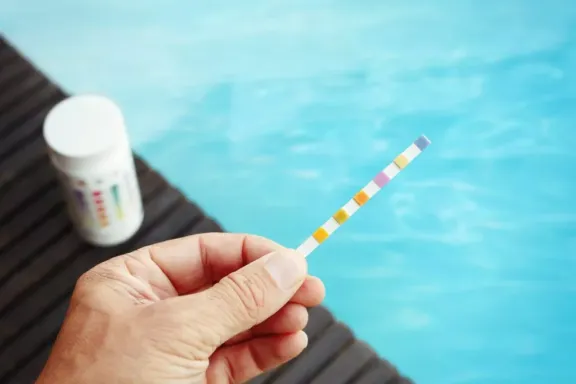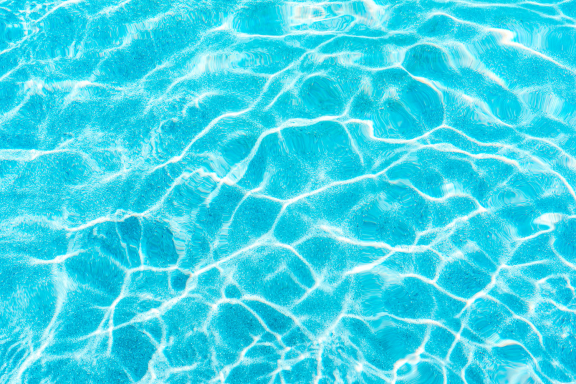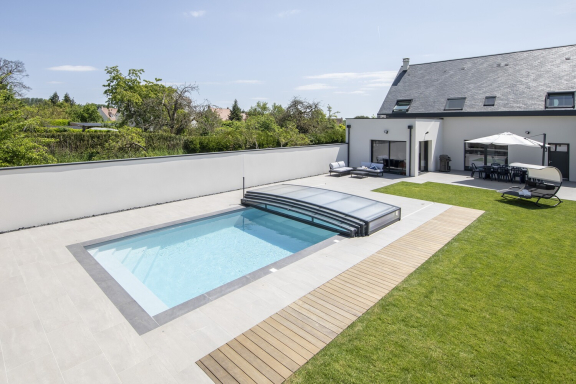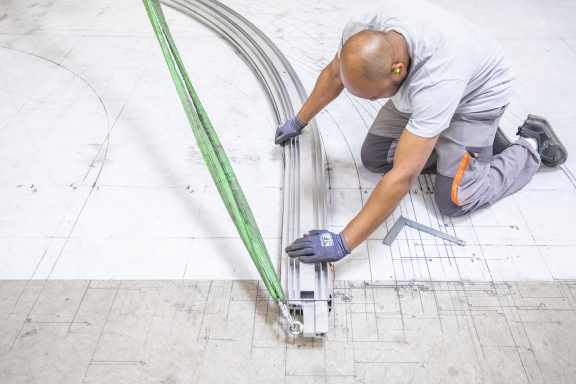Pool water testing: how do you do it?
Pool maintenance does not just mean cleaning the dead leaves that fall into the water. It also means carrying out regular tests to ensure the proper balance is maintained. So, how do you test your pool water? What should you measure? What equipment do you need? Discover our complete guide.
Why analyse pool water?
Testing your pool water ensures that you maintain a healthy bathing environment with water that is a pleasure to swim in.
By regularly analysing the water of your pool, you check that it is well balanced and that the treatments applied are still effective against the bacteria and micro-organisms that can develop in the water.
Properly conducted maintenance also enables you to anticipate the problems that can arise in an aquatic environment, includingthe development of algae. If, despite all your efforts, algae still develops, an analysis of the water will help you understand the origin of the problem and enable you to find the best solution to recover healthy water.
How does pool water become unbalanced?
The importance of regular pool water testing is due to the many factors that can disturb its balance.
Changes in temperature
An increase in outdoor temperature, which generally also increases that of the pool water, may be pleasant for swimming but can disrupt the balance of the water. It then becomes necessary to run the filtration system longer, but it is also important to know that disinfecting products may become less effective.
Severe weather
Rain is another factor that can disturb water quality. Rainwater is necessarily different than the water in your pool. When it rains, particularly during heavy storms, rainwater mixes with pool water and thus disturbs its pH balance.
Dirt
Debris from dust, sand, earth and dead leaves will fall into the pool. They are driven by the wind but are also introduced by pool users when they enter the water or walk by the pool side. All these forms of dirt are an additional factor that can perturb the balance of pool water.
The sun
UV rays act on the chlorine contained in pool water. Indeed, chlorine evaporates when exposed to UV rays. If the quantity of chlorine in the water drops excessively, its anti-bacterial action becomes less effective, hence the importance of regular measurement.
The region
The region you live in also influences maintenance and the steps to take, and not only due to sunshine and temperature.
Certain regions have harder water, which influences the TH level and thus the stability of the pH. Knowing the quality of the water in your municipality will help you adapt your maintenance accordingly.

How can you know if your pool water is healthy?
Cloudy or, even worse, green water, immediately signifies that it is not healthy. What exactly does that mean? This polluted water will be harmful to users and may trigger allergic reactions or irritations. Unhealthy water can also damage your installations and equipment.
However, water quality cannot always be judged by the naked eye. When the problem becomes visible, it is usually because it has seriously deteriorated and will be more complicated to correct. Clear water may therefore already be unbalanced and if it is not remedied quickly, you will find yourself with additional complications.
Performing regular and rigorous testing is the only way to know for sure whether your pool water is healthy or not. These tests are therefore an important part of pool maintenance for both in-ground and above-ground pools.
Pool water analysis: what should you measure?
Perhaps you already know that water pH must be regularly checked. However, it is not the only important factor in water analysis. Indeed, it is just as important to monitor the TAC, TH, and, of course, the quantity of water treatment products.
pH
Water pH is its potential of hydrogen. Measured on a scale of 0 to 14, it indicates the alkaline character of the water, with the lowest value being highly acidic and the highest being highly alkaline. Neutral pH is around 7.
The pH level in pool water ensures the effectiveness of the disinfectant product used. It is a sensitive element that deserves particular attention because it can easily rise or fall.
TH
TH is Total Hardness. It is the water mineralisation or hardness index. It indicates the quantity of salts, calcium and magnesium present in the water. Water hardness is measured in French degrees (expressed as °f – not to be confused with Fahrenheit degrees, expressed as °F), on a scale of 0 °f to 45 °f.
TAC
TAC, or Total Alkalinity, represents the alkalinity of the water, i.e. the concentration of carbonate and bicarbonate ions in the water. This alkalinity influences the stability of the pH. A poor TAC level generally means that the pH is also unbalanced. TAC is measured in French degrees (°f), parts per million (ppm) or milligrams per litre (mg/L).
Disinfectant
The quantity of disinfectant present in the water must be checked regularly to ensure that its anti-bacterial effect remains effective, regardless of the treatment method used (chlorine, bromine, salt electrolysis, active oxygen, etc.).
Stabiliser
Stabiliser is used for chlorine pools. Thanks to the action of cyanuric acid, it stabilises the disinfectant to prevent it from being destroyed by solar UV rays. It also eliminates the need to add chlorine to the pool water too frequently.
Its disadvantage: it does not evaporate and if the water contains too much, the chlorine can no longer react. It is therefore necessary to measure it regularly, especially before adding more, to ensure that it is really necessary.
Water temperature
The water temperature should be measured frequently because it influences other factors. It notably determines the duration of daily filter operation. Water temperature is also important for the dosing of certain treatments, especially chlorine. Water that is too warm or cold can hinder the action of chlorine.
What levels should you maintain in a pool?
Monitoring pool water is not all – you must still be aware of the acceptable levels to rapidly identify any imbalance.
The pH level
It is generally recommended to maintain a level between 7.2 and 7.4. This pH level ensures the best possible bathing comfort and helps to keep the water clean.
pH can drop very quickly and easily, so it is especially important to be vigilant and ideally to measure it once a week.
Below 7.2, the pH is too low. This is known as acidic pH. The water then becomes more aggressive to users, and can cause mucus and eye irritation. Low pH can also corrode and damage the filtration system.
NB: the ideal pH level for your pool also depends on the treatment you use to disinfect the water. pH between 7.2 and 7.4 is recommended for chlorine treatment.
The TH level
Pool TH should be in the range of 10 °f to 35 °f (French degrees).
TH that is too high will cause problems due to water hardness. Limescale deposits will appear and potentially damage your equipment and pool walls, or cause skin irritation.
Excessively low TH is also an irritant to users and may cause the corrosion of your equipment.
The TAC level
TAC should be between 80 and 120 mg per litre of water, i.e. between 8 °f and 12 °f (French degrees) or between 80 and 120 ppm.
If it is too low, the pH may change quickly and will be more difficult to stabilise. If it is too high, you once again risk seeing the development of limescale on the liner, equipment and piping.
The stabiliser level
The quantity of stabiliser must be between 20 and 30 mg/L. If there is not enough stabiliser, the chlorine will evaporate more quickly and you will soon have to add more. If, on the contrary, the water is over-stabilised, chlorine action will be impeded.
It is quite easy to over-stabilise your pool, because the stabiliser accumulates in the water and the quantity gradually increases.
In both cases, whether because the chlorine is inactive or because it has evaporated too quickly, the water is insufficiently disinfected, leaving room for the development of algae and bacteria.
The disinfectant level
The quantity of disinfectant necessary for your installation will depend on the method you choose to treat the water.
For a chlorine pool, it is considered that between 1.5 and 2 mg/L of chlorine is necessary. If there is too much chlorine, the water risks irritating users. If there is not enough, the water will not be correctly disinfected.
What equipment is necessary to test pool water?
Several solutions exist to test pool water. These tests are quick to perform and it is not always necessary to rebalance the water after testing.
Test strips
Quick and easy to use, test strips enable you to measure a number of elements concerning your pool water: pH, hardness, the chlorine level, the quantity of stabiliser, the alkalinity or even the quantity of algaecide.
The test strips must be dipped into the water for a few seconds at 20 to 30 centimetres from the pool edge. The strips change colour on contact with the water. After a few minutes, you can interpret the result with the colour chart printed on the packaging. As a general rule, the darker the test strip, the higher the level.

Tablets and liquid reagents
Like test strips, tablets and liquid reagents enable manual testing.
To use these chemical products, it is necessary to take a sample of pool water in a flask. A reagent is then mixed with the sample in the flask. The water changes colour on contact with the reagent and you can interpret the results thanks to the information printed on the packaging.
Test kits
Pool water test kits contain everything you need for your measurements. You will generally find a liquid reagent or tablets, as well as test tubes and the equipment necessary to interpret the results.
It all comes in a case to facilitate product storage and use.
Electronic testers
Reliable and easy to use, electronic testers are more expensive but are very practical. With this type of device, you will no longer need to perform colour assessments as with test strips. They generally measure pH and the disinfectant. Devices that measure pH alone are called pH meters.
Electronic testers are immerged either directly into the pool or into a sample taken beforehand. The water is analysed within a few seconds and you obtain precise and reliable results.
These devices are nonetheless fragile and must be handled with care. They must be reset at the beginning of the season and at least once during the season to ensure the precision of the results.
Smart monitors
New technologies are also available to analyse your pool and make life easier for you. Connected water monitors are placed directly in the pool and remain there continuously. They then transmit the results of all water analyses to you via a smartphone application.
The advantage: not only do they eliminate the need to perform the measurements yourself, but they provide access to the measured data in real time at any time of the day.
Another advantage: you will receive notification if there is an imbalance in the water and you can take action accordingly.
Smart monitors provide precise and reliable information by analysing pH, TAC, TH and disinfectant as well as additional measurements like water temperature, the UV index or the weather.
How can you correct pool water after a negative test?
Testing shows that your water is unbalanced. How can you correct the different levels to recover healthier water?
Correcting pH
To raise or lower the pH level of your water, simply use a product called pH+ or pH-. pH+ will increase the pH level, while pH- will lower it.
After using one of these two products, analyse the pH again to ensure that it is satisfactory. Be careful to apply a pH level that is suitable for your water treatment method.
You should be aware that your water treatment may be more or less sensitive to pH, so in certain cases you will have to correct it more frequently and be more vigilant.
Correcting TH
When the TH level is too low, simply use a hardness increaser, which contains calcium chloride. If you partially drain your pool, it will certainly be necessary to use a hardness increaser when you fill it again.
If, on the contrary, the water is too hard and the TH is too high, you will have to use a calcium sequestering agent. Some of these products also act as a flocculant, clumping together the finest calcium particles so that they can later be vacuumed. Another solution for excessively hard water: install a water softener in the pool supply network.
Correcting TAC
If the TAC is too high, you will have to correct it with chlorohydric acid. If it is too low, a product containing sodium bicarbonate will increase it.
You should monitor the TAC level after adding pH+ or pH-. Indeed, these products can modify the TAC, especially if they are introduced too quickly or are used in too large quantities. In contrast, also monitor the pH when you try to correct the TAC because the products used may also increase or decrease it.
Correcting the quantity of chlorine
When the chlorine level is too low, it is time to add more. It comes in the form of granules or tablets that you place directly in the skimmers. Then allow the filtration to operate, and once more check that the chlorine and pH levels are correct.
If you have a chlorine-free pool, you will not necessarily have to correct the concentration of disinfectant very often. With a bromine treatment managed by a brominator, you will have to add the product approximately every two weeks. With salt electrolysis, which operates on a perpetual cycle, the quantity of salt needs only to be checked once or twice a year.
Frequent errors when testing pool water
You regularly test your pool water, which is a very good thing. But did you know that certain actions and habits can distort the results and lead you into error over the treatment you apply? Here are a few frequent errors to avoid when testing your pool water.
Waiting before testing the sample
Your water sample may continue to change after you have taken it. It can be transformed by factors like air, light and humidity. The failure to test a sample immediately after you have taken it creates a risk of obtaining an erroneous result, and thus of incorrectly treating your pool.
Before taking your sample, prepare all the equipment necessary for the test and perform all the measurements, and continue with the appropriate treatment if necessary.
Taking a sample in the wrong place
It is important to take a sample from the right place in your pool for testing. Indeed, the water may be slightly different from the rest of the pool if you take samples around the nozzles, ladders, steps or corners.
What interests you is the quality of the water at around 30 centimetres below the surface at mid-distance between the deepest and shallowest sides. By taking your sample in this location, you are sure to obtain a sample that best represents the overall quality of the water.
Using expired or damaged products
Pay attention to the materials you use to test your sample: test strips, tablets and reagents must still be usable. This means that you should avoid products that have expired or which have been poorly stored and which therefore may be damaged.
Using expired or damaged products may distort the results and lead you into error over the treatment to apply in your pool. Store your material away from sunlight, humidity, frost and intense heat to ensure correct use.
Using a dirty test kit
Avoid soiling the reactive parts of flasks and test strips by touching them with your fingers (and also to avoid skin irritation). Rinse the reusable flasks carefully after each use and dry them well.
Indeed, dirty equipment may compromise the results and lead you into error.
Have your pool water tested by a professional
A pool maintenance service can test your pool water for you.
Having your pool water tested by a professional
A pool maintenance service can test your pool water for you.
When should you use the services of a professional?
Of course, a professional can manage the entire maintenance of your pool and take all measurements on a weekly basis. However, if you wish to limit your pool budget, you will certainly want to carry out this monitoring and maintenance yourself.
You may nevertheless call on a professional from time to time. Indeed, having your pool tested by a professional once or twice a year will further ensure you of a healthy pool environment.
A pool maintenance service will be equipped with very precise tools. They will thus thoroughly analyse your water, including data that you do not usually measure. You will thus have a better idea of the quality of your water and receive personalised advice to continue your own pool maintenance.
How can you have your pool water tested by a professional?
To find a professional who can analyse your water, you can simply look for someone who takes care of pool maintenance. You can also seek information from the company that installed your pool, or specialized retailers, some of which can perform this service themselves.
How do you test the water of a hot tub?
The analysis of hot tub water uses the same products and procedures as for a pool.
What is healthy hot tub water?
The warm environment of a hot tub makes it an ideal place for the development of bacteria. So you should pay particular attention to the quality of your water. You should try to maintain your water with:
– pH between 7.0 and 7.4;
– TAC between 125 and 150 mg/L, i.e. between 10 °f and 30 °f (French degrees);
– A TH level between 10 °f and 20 °f (French degrees), i.e. 100 to 200 mg/L.
How do you preserve the balance of a hot tub?
As for a pool, regular analysis of the water of the hot tub and proper cleaning will ensure you of clean water.
You can also cover your hot tub when not in use to keep the water clean. Finally, ask those who use the hot tub to shower before entering the water.

What products are necessaryto treat your pool?
Three elements are necessary to ensure you have clean pool water for swimming.
Disinfectant
You first need a water treatment method. Chlorine is the most common solution, but you may choose salt electrolysis, bromine or UV treatment.
Filtration
You will then need a filtration system that enables the water to circulate and which will remove unwanted particles. A sand filter is a common solution, especially with chlorine.
To know how long your filter must run every day, start with the water temperature and divide it by two. A pool at 24 °C must therefore be filtered during 12 hours.
Additional treatment products
Finally, you will also need several additional chemical treatment products to ensure proper maintenance: a flocculant, algaecide, anti-limescale, stabiliser, pH+ and pH-, etc.
These products will help you readjust the balance of your pool or provide further protection against algae and bacteria.
Special cases: adapting to the water treatment
Each method of disinfection has particularities that will influence not only the different products you use, but also the tests to carry out and their frequency.
For a salt pool, for example, it will be important to measure the quantity of salt using test strips or a salt meter. Also pay attention to the pH, because salt treatment is very sensitive to it. Like chlorine, the pH should be between 7.2 and 7.4. To manage it more easily, you can install a pH regulator that will take care of testing and adjust it automatically.
Bromine is another particular case that requires higher pH, between 7.5 and 8. Bromine is rather tolerant of fluctuations in pH, but that does not mean it should not be measured regularly. The brominator, which constantly releases bromine into the pool, may also be equipped with a pH regulator.
Pool water analysis is an important task that should not be neglected. It can quickly become a habit and does not take much time if done regularly. If you find it difficult to find the time, you can make things easier for yourself by acquiring the right equipment.


